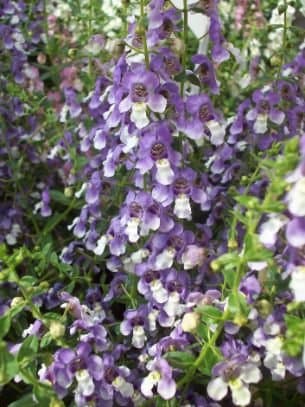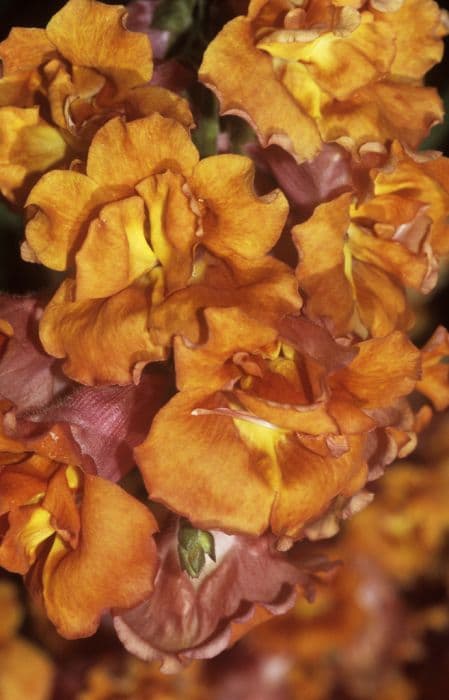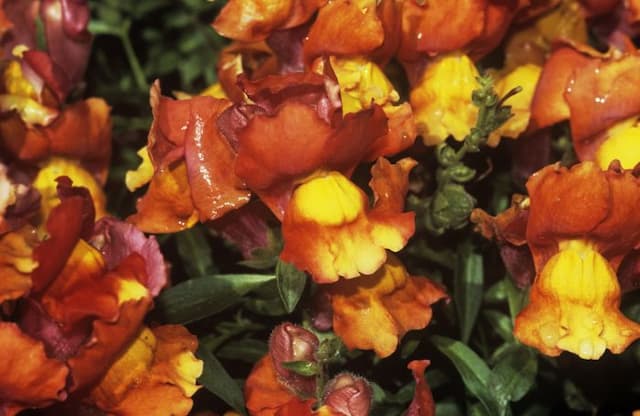Beardtongue Penstemon 'Pensham Laura' (Pensham Series)

ABOUT
Penstemon 'Pensham Laura', also commonly known as beardtongue, is a striking perennial plant characterized by its vibrant and showy flowers. The blooms of 'Pensham Laura' are particularly attractive due to their rich coloring—a gradation of pink tones. Each trumpet-shaped flower boasts a wide-open mouth with a white throat, often marked with an inviting pathway of deep purple lines that lead pollinators to the flower's center. The flowers are arranged in clusters along tall spikes, giving the plant a vertical aspect and adding to its visual appeal. The foliage of beardtongue 'Pensham Laura' is equally alluring, composed of lance-shaped leaves that maintain a lush green throughout the growing season, providing a lovely contrast against the pink flowers. These leaves are generally smooth with a fine texture, that grows in a well-structured form, adding to the tidy and elegant appearance of the plant. Beardtongue is often praised for both its ornamental beauty and its ability to attract beneficial wildlife, such as hummingbirds and butterflies, who are drawn to its blooms. Its striking flowers and complementary foliage make 'Pensham Laura' a popular choice for gardeners looking to add a pop of color and an element of structural interest to their garden beds or borders without discussing its specific dimensions.
About this plant
 Names
NamesFamily
Plantaginaceae
Synonyms
Beardtongue, Penstemon
Common names
Penstemon 'Pensham Laura' (Pensham Series).
 Toxicity
ToxicityTo humans
Penstemon 'Pensham Laura' is not commonly known to be toxic to humans. If you suspect poisoning or experience unusual symptoms after handling or ingesting this plant, it is advisable to consult a medical professional.
To pets
Penstemon 'Pensham Laura' is not commonly known to be toxic to pets. However, individual animals may have different sensitivities, and it's best to prevent your pets from ingesting this plant. If your pet exhibits signs of illness after consuming any part of the plant, consult your veterinarian.
 Characteristics
CharacteristicsLife cycle
Perennials
Foliage type
Deciduous
Color of leaves
Green
Flower color
Pink
Height
2-3 feet (0.6-0.9 meters)
Spread
2 feet (0.6 meters)
Plant type
Herb
Hardiness zones
5
Native area
North America
Benefits
 General Benefits
General Benefits- Attracts Pollinators: Penstemon 'Pensham Laura' is known for attracting bees, butterflies, and other beneficial insects, which are crucial for pollination and maintaining a healthy ecosystem.
- Drought Tolerance: Once established, it is relatively drought-tolerant, making it suitable for gardens in arid climates or for gardeners looking to reduce water usage.
- Long Blooming Season: This plant boasts a long flowering period from early summer to autumn, providing extended visual interest in the garden.
- Low Maintenance: Penstemon 'Pensham Laura' requires minimal upkeep once established, with no need for complex pruning or care routines.
- Herbaceous Perennial: As a perennial, it provides a lasting presence in the garden, growing back year after year.
- Cold Hardy: It is capable of withstanding cold temperatures, making it suitable for planting in a variety of climates.
- Ornamental Value: The vibrant tubular flowers add aesthetic appeal to any garden design, whether used in borders, beds, or as container plants.
- Deer Resistance: Penstemon 'Pensham Laura' is generally resistant to deer, which can help prevent damage in areas where deer browse.
- Versatility: Its upright habit and colorful blooms make it versatile for use in mixed borders, cottage gardens, or rock gardens.
 Medical Properties
Medical PropertiesThis plant is not used for medical purposes.
 Air-purifying Qualities
Air-purifying QualitiesThis plant is not specifically known for air purifying qualities.
 Other Uses
Other Uses- As a natural dye: The richly colored flowers of the Beardtongue can be used to create natural dyes for fabrics, offering hues ranging from pinks to purples depending on the mordant used.
- In art and photography: The Beardtongue's striking flowers make it an excellent subject for botanical illustration, watercolor, and photography, capturing its vivid colors and intricate shapes.
- Educational tool: The diverse structure of the Beardtongue flowers can serve as an educational example to teach pollination biology and the relationship between flower form and function.
- Floral jewelry: The flowers and leaves of the Beardtongue can be used to make delicate floral jewelry, such as pressed flower pendants or earrings, due to their attractive shapes and colors.
- Bookmark decoration: Dried Beardtongue flowers can be laminated and used as unique and personal bookmarks, preserving their beauty for long-term use.
- Greeting cards and paper crafting: The flowers of the Beardtongue can be used in crafting personalized greeting cards or as embellishments in scrapbooking projects.
- Textile pattern inspiration: Beardtongue's aesthetic florals can inspire designs and patterns for textiles, such as for clothing, curtains, or upholstery fabric.
- Table centerpiece: Beardtongue, with its long-lasting blooms and upright habit, can be used to create attractive table centerpieces for events and home decor.
- Garden photography backdrops: The dense, colorful spires of Beardtongue can serve as a vibrant backdrop in garden photography, enhancing the visual appeal of other photographed plants or garden features.
- As a muse for poetry and literature: The beauty of the Beardtongue flowers can evoke artistic expressions and be woven into poetry, prose, and literary descriptions.
Interesting Facts
 Feng Shui
Feng ShuiThe Beardtongue is not used in Feng Shui practice.
 Zodiac Sign Compitability
Zodiac Sign CompitabilityThe Beardtongue is not used in astrology practice.
 Plant Symbolism
Plant Symbolism- Persistence: Penstemons are hardy plants that can thrive in challenging conditions, symbolizing perseverance and the ability to endure tough circumstances.
- Health and Vitality: The vibrant blooms of the Beardtongue represent robust health and a zest for life, encouraging a positive outlook and wellbeing.
- Beauty: With its striking flowers, the Beardtongue symbolizes appreciation for beauty, both in nature and in human life.
- Grace: The elegant shape of the Beardtongue's flowers is often associated with grace and dignity in challenging situations.
- Communication: The plant's common name, Beardtongue, implies a connection to speech and communication, possibly representing an open exchange of thoughts and feelings.
 Water
WaterBeardtongue should be watered deeply once a week during its growing season, making sure the soil is moist but not waterlogged. Depending on weather conditions, you may adjust the frequency to account for rainfall or particularly hot, dry periods. In general, about 1 inch of water per week either from rainfall or manual watering should suffice. During winter, reduce watering to only when the soil is dry to the touch as the plant goes dormant. Be cautious not to overwater, as this can lead to root rot.
 Light
LightFor Beardtongue, full sun to partial shade provides the best light conditions for flowering and growth. Plant your Penstemon 'Pensham Laura' in an area where it will receive at least six hours of sunlight each day. Too much shade can result in fewer blooms and a leggy plant.
 Temperature
TemperatureBeardtongue thrives in a range of temperature conditions and is hardy in USDA zones five through nine, enduring minimum temperatures down to -20°F. The ideal temperature range for robust growth and flowering is between 60°F and 75°F. Penstemon 'Pensham Laura' can tolerate high summer temperatures as well if adequately watered.
 Pruning
PruningPruning Beardtongue is necessary to encourage bushier growth and more flowers. Deadhead spent blooms regularly to stimulate new flower production. In early spring or after the first flush of blooms, cut back the stems by up to one-third to maintain a tidy shape and promote a second round of flowering. Pruning in late fall or early winter after the flowering has ceased can help prepare the plant for the next growing season.
 Cleaning
CleaningAs needed
 Soil
SoilBeardtongue 'Pensham Laura' requires well-draining soil enriched with organic matter. A soil mix containing equal parts garden soil, compost, and perlite or coarse sand is ideal. The soil pH should be slightly acidic to neutral, ranging from 6.0 to 7.0 for optimal growth.
 Repotting
RepottingBeardtongue ‘Pensham Laura’ does not need to be repotted often as it's perennial. Repot every 2-3 years in spring to refresh the soil and allow space for growth.
 Humidity & Misting
Humidity & MistingBeardtongue 'Pensham Laura' prefers moderate humidity levels but is quite adaptable. It does not require any special humidity conditions and will thrive in the ambient humidity of most temperate climates.
 Suitable locations
Suitable locationsIndoor
Place in bright light, avoid over-watering, ensure good air circulation.
Outdoor
Full sun to partial shade, protect from harsh winter weather.
Hardiness zone
5-9 USDA
 Life cycle
Life cyclePenstemon 'Pensham Laura' begins its life cycle when seeds are sown in late winter to early spring, germinating under warm conditions. The seedlings grow and establish themselves, developing a strong root system. Once mature enough, the plant starts vegetative growth, producing lance-shaped leaves and strong stems. During late spring and into summer, the plant enters the flowering stage, showcasing tall spikes of tubular bell-shaped flowers that are attractive to pollinators such as bees and hummingbirds. After pollination, the plant sets seed in late summer to early fall, completing its reproductive cycle. Throughout fall and winter, the Penstemon may exhibit dormancy, especially in colder climates, only to regrow from its perennial rootstock with the onset of the next spring.
 Propogation
PropogationPropogation time
Spring-Summer
Propogation: The best time to propagate Penstemon 'Pensham Laura' is during the late spring or early summer when the plant is actively growing. The most popular method of propagation for Penstemons, including the 'Pensham Laura', is through stem cuttings. To do this, select a healthy, non-flowering stem and cut a 4 to 6-inch (about 10 to 15 cm) section just below a node, which is where leaves emerge from the stem. Remove the lower leaves to expose a clear length of stem. Dip the cut end into a rooting hormone powder to increase the chances of successful rooting. Then, plant the cutting in a moist, well-draining potting mix, and place it in a warm spot with indirect sunlight, ensuring to keep the soil consistently moist but not soggy. Roots usually develop within a few weeks, after which the new plants can gradually be acclimated to outdoor conditions and eventually transplanted into the garden.









